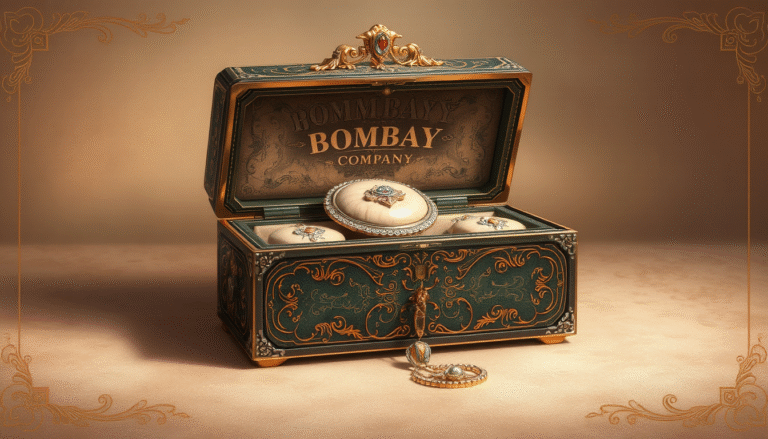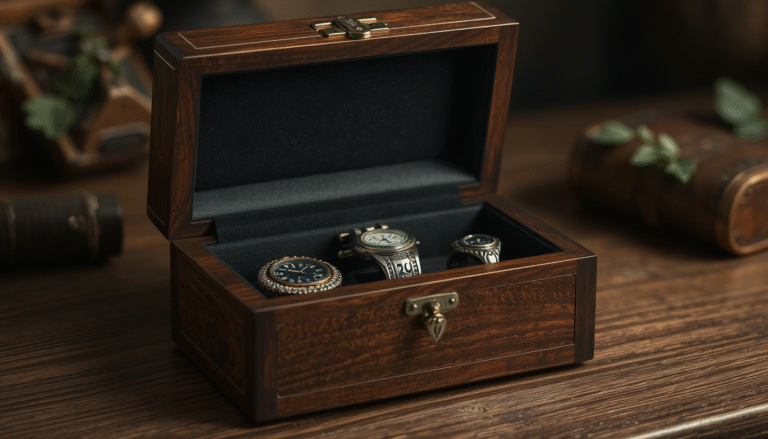Introduction
Imagine a box, its surface an opalescent expanse of intense black or crimson lacquer woven with delicate iridescent threads of mother-of-pearl inlay. The interior is covered with silk fabrics to hold sweet treasures. This isn’t just a vessel; it’s a china jewelry box, a miniature form of architecture that captures within it centuries of genius, cultural significance, and human history.
We encourage you to think beyond the function and explore the deep world of these little guys. A china jewellery box You’ve got to accept that the one that opens a china jewellery box has a kind of art in their hands.
The Soul of Craft: Unveiling the Traditional Chinese Jewelry Box
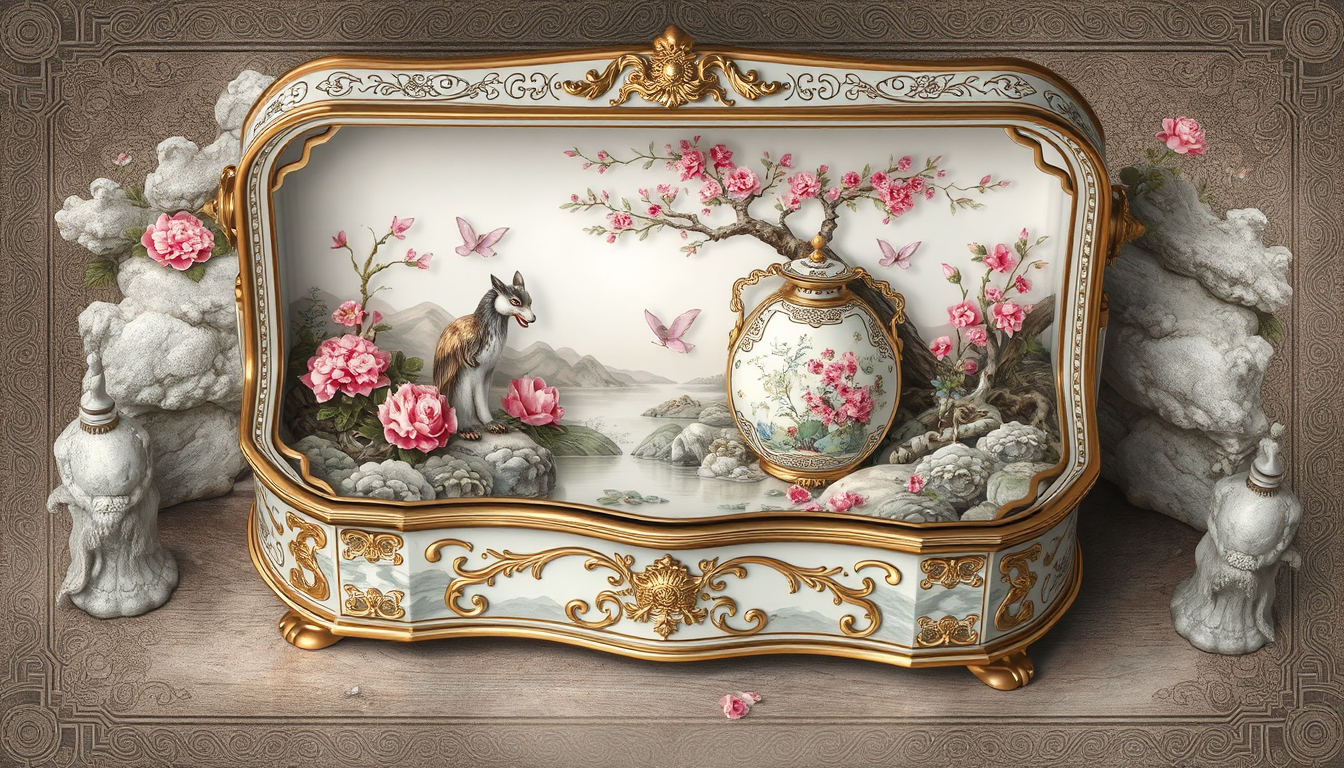
A Vessel of Memories and Heritage
To the Chinese, a jewelry box is just as much as a jewelry box. It is a traditional object with deep meaning in the bride’s dowry idealizing blessings for a happy marriage.
These boxes are frequently passed from one generation to the next, and are treasured family heirlooms that are used to store valuable jewelry, important documents or valuable mementos. You are in fact being paid a very high honour and respect, when anyone gives you one as a present.
Defining Features: From Form to Function
The design of a traditional Chinese jewelry box shows elegant efficiency. While styles vary, several features stand out and show the cleverness of their makers.
-
Multi-layered Design: Many boxes have stacked drawers and trays, letting you organize different types of jewelry, from tiny earrings to heavy jade bangles.
-
Silk or Brocade Lining: The lining is almost always a soft, either silk or patterned, lining used to prevent metals and gems from getting scratched up in the bag. These designs often have specific connotations.
-
Concealed Compartments: Many old boxes have hidden drawers or secret spaces, showing both the maker’s skill and the owner’s need for privacy.
-
Integrated Mirror: Often, the lid’s underside has a mirror, sometimes made of polished bronze in older pieces, for practical use.
-
Ornate Hardware: Polished brass or bronze clasps, hinges, and handles are both useful and decorative, often shaped like butterflies or bats.
A Journey Through Dynasties: The History of the Chinese Jewelry Box
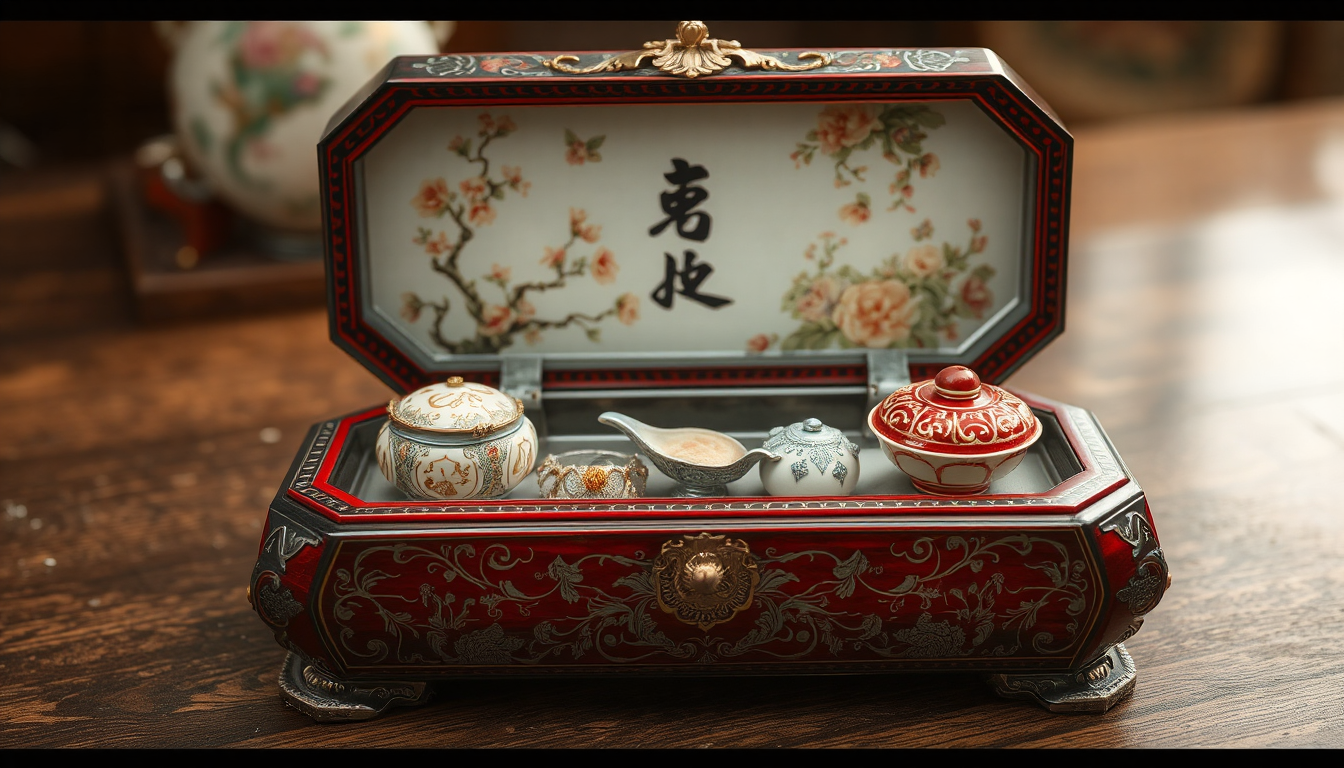
Early Origins and Tang Dynasty Flourishing
The notion of fancy containers for valuables is an old one in China. This art form really took off during the Tang Dynasty (618-907 AD), a time of wealth and cultural mixing along the Silk Road.
As new materials and ideas flowed into China, craftsmanship reached new heights. During this time, the intricate art of Chinese lacquerware became highly advanced, with complex carving and inlay techniques being applied to boxes and furniture.
Ming and Qing Dynasties: The Golden Age of Craftsmanship
The Ming (1368–1644) and Qing (1644–1912) Dynasties are the heydays of Chinese decorative arts. Workmanship became highly trained, as the demand of court was for perfect work.
I Physical And Political Conditions 6 One feature of this golden age was the widespread symbolism of the china jewelry box as exemplifying the noble and rich merchant family’s status. Workshops produced some incredible works in precious hardwoods such as Zitan and Huanghuali, inlaid with carved lacquer, jade, and ivory, as well as fine painting. How fancy or fancy a family’s jewelry box was dictated that family’s social class and wealth.
Modern Interpretations
Though the era of empire is over, this artistry endures. Today, Chinese jewelry boxes are still being handmade by artisans practicing traditional methods and skills handed down through generations.
And as it happens, modern designers are revitalizing these classic silhouettes, combining tried-and-true looks with modern sensibilities to create new heirlooms for the current era.
Decoding the Secrets: A Guide to Symbolism in Chinese Jewelry Box Art
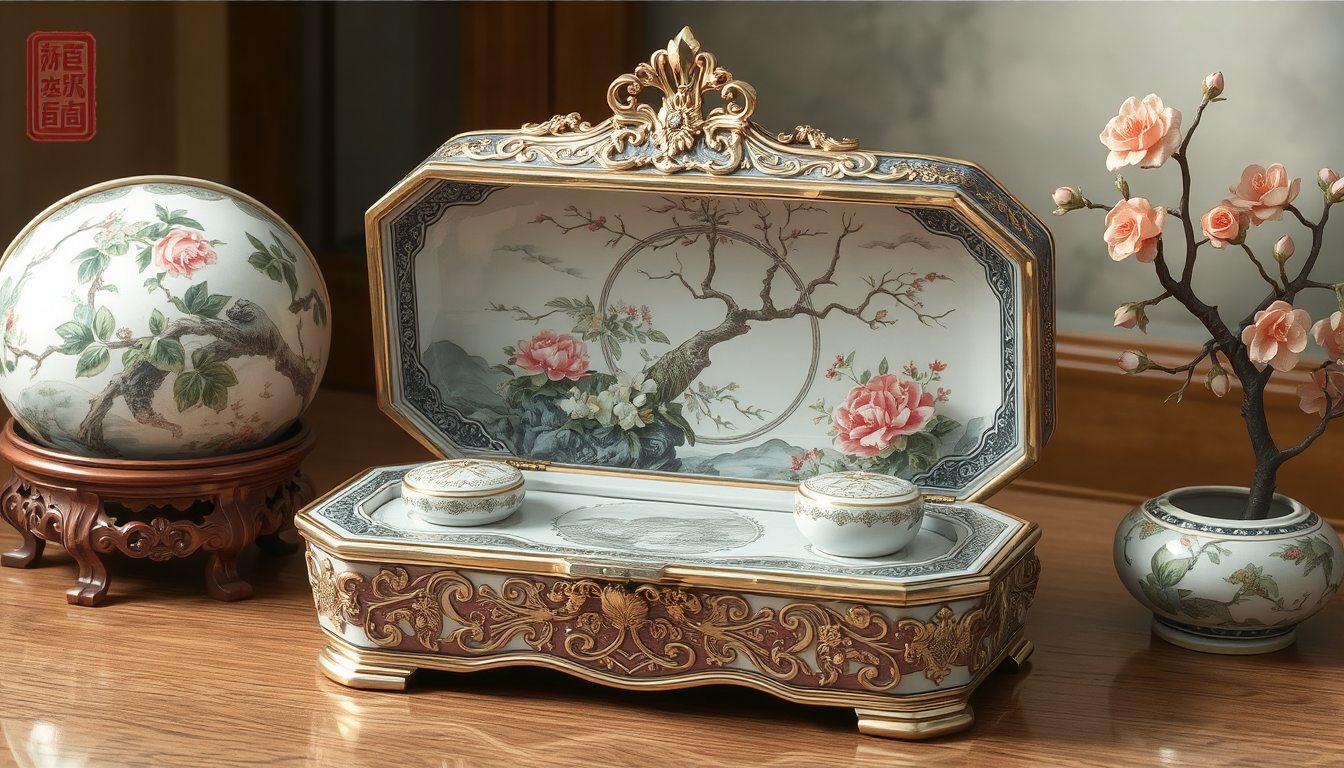
More Than Decoration: A Language of Blessings
To truly appreciate a china jewelry box, you must learn to read its visual language. In Chinese art, every element has purpose; nothing is merely decorative.
These images form a vocabulary of lucky symbols, expressing wishes for long life, happiness, wealth, and good fortune. When you understand this symbolism, the box changes from a pretty object into a meaningful story of blessings, as shown when decoding the rich symbols in Chinese art.
Common Motifs and Their Meanings
The following table provides a guide to some of the most frequently seen motifs on Chinese jewelry boxes.
| Motif (图案) | Symbolism (象征意义) | Brief Explanation (简要解释) |
| Fauna (动物) | ||
| Dragon (龙) | Power, Good Fortune, The Emperor | The ultimate symbol of cosmic energy (qi) and strength. The dragon is a benevolent creature that controls water and rainfall, representing imperial power and unparalleled luck. |
| Phoenix (凤凰) | Virtue, Beauty, The Empress | The mythical queen of birds, the phoenix appears only in times of peace and prosperity. It symbolizes beauty, luck, and the feminine virtues of the Empress, often paired with the dragon. |
| Crane (鹤) | Longevity, Wisdom | Believed to live for a thousand years, the crane is a powerful symbol of a long life and immortality. Its presence bestows a wish for enduring health and wisdom. |
| Bat (蝠) | Good Fortune, Happiness | The Chinese word for bat, “fú” (蝠), is a homophone for the word for good fortune (福). Therefore, a bat, or a group of five bats, represents the arrival of good luck and the Five Blessings. |
| Mandarin Ducks (鸳鸯) | Marital Fidelity, Bliss | These ducks are believed to mate for life. A pair of Mandarin ducks is a classic symbol of a loving, devoted, and harmonious marriage, making it a very common motif on dowry boxes. |
| Flora (植物) | ||
| Peony (牡丹) | Wealth, Honor, Royalty | Known as the “king of flowers,” the lush and vibrant peony is a symbol of riches, high social status, and aristocratic beauty. |
| Lotus (莲花) | Purity, Spiritual Enlightenment | The lotus flower rises unstained from the muddy water, symbolizing purity of heart and mind, and the journey toward spiritual enlightenment in Buddhism. |
| Bamboo (竹) | Resilience, Integrity, Longevity | Bamboo bends without breaking, representing the strength, flexibility, and integrity of a gentleman. As an evergreen, it also symbolizes a long life. |
| Plum Blossom (梅花) | Perseverance, Hope, Beauty | The plum blossom bravely flowers in the cold of late winter, symbolizing resilience in the face of adversity, endurance, and the promise of hope and renewal that spring will bring. |
| Symbols (符号) | ||
| Double Happiness (囍) | Marital Bliss | This character is a ligature of two “xi” (喜, happiness) characters. It is used exclusively for weddings to represent the joyous union of the couple. |
| Shou (寿) Character | Longevity | The “shou” character, often depicted in stylized or calligraphic forms (sometimes with over 100 variations), is a direct and powerful wish for a long and healthy life. |
A Connoisseur’s Guide to Choosing Your Chinese Jewelry Box
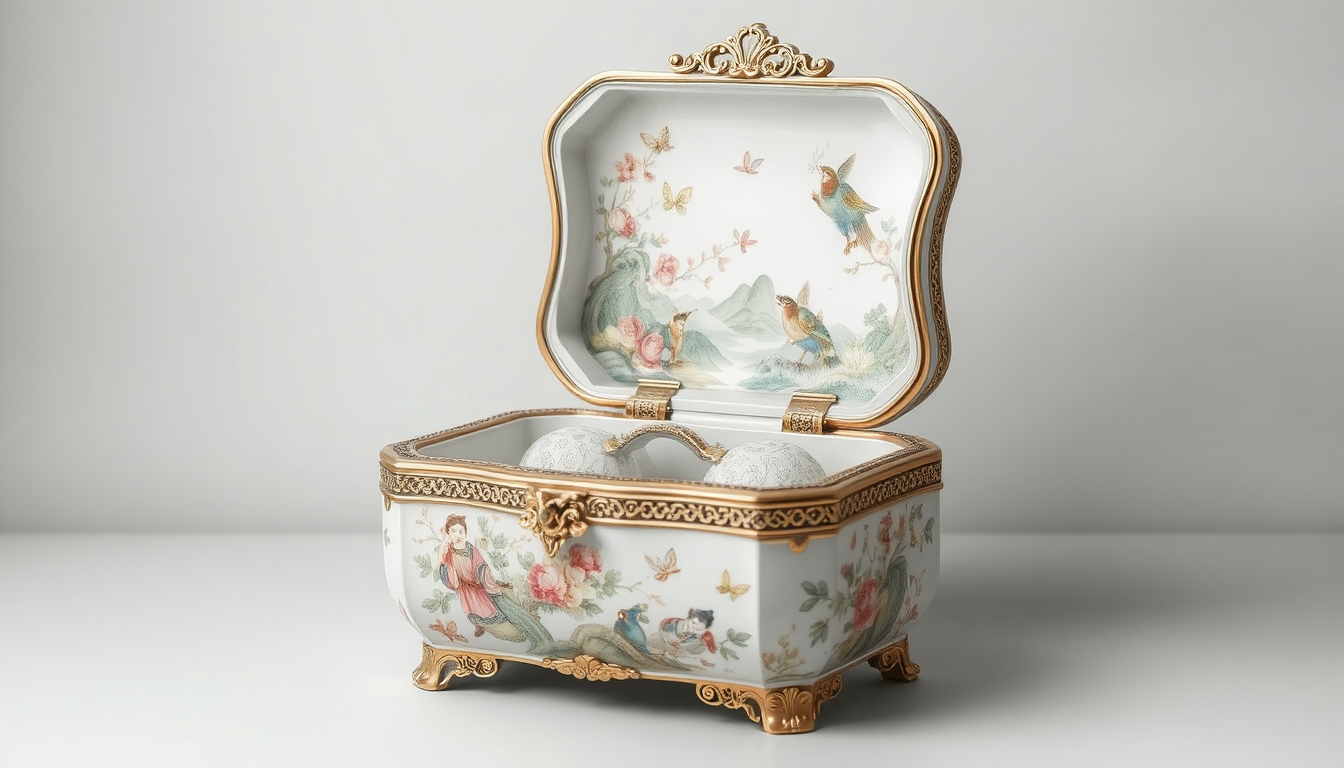
Understanding Key Materials and Craftsmanship
Picking a quality china jewelry box requires attention to detail. Focus on the materials and the quality of the work.
-
Lacquerware: Look at the surface. The best lacquer is deep and shiny and feels smooth to the touch. If there are carvings on it, the cuts should be sharp and clean, not fuzzy. The finer the piece, the more layers of lacquer it might have, which adds a unique depth.
-
Wood: Conventional boxes are made with dense hard sweet smelling woods. Redwood (红木, hóngmù) is appreciated for its color and grain. Camphorwood (香樟木, xiāngzhāngmù) is known for its pleasant aroma and natural insect-repelling virtues, so it’s excellant to store precious fabrics or papers, not to mention jewelry.
-
Inlays:With inlay work, pay close attention to how the material was placed. (Mother-of-pearl, abalone shell and stones like jade should fit perfectly, with no gaps or visible glue.) How accurate the inlay is, is an obvious indicator of the level of expertise of the maker.
Antique vs. New: What to Look For
It’s up to you to decide whether you want an old box or a new box, but the good news is that the quality marks are different.
-
For Antiques: Seek a true patina — the gradual wear and softening of surfaces that occurs as an object ages. This can’t be faked well. Inspect joints Traditional pieces feature intricate fitting joints, not modern nails and screws. Embrace small, honest repairs as a part of an object’s narrative.
-
For New/Reproductions: Here, focus on perfect execution. Check the finish quality and material authenticity. A strong, chemical smell from the finish is a warning sign of lower quality materials. Make sure all drawers and lids work smoothly.
Questions to Ask Before You Buy
To make a smart purchase, prepare a few questions for the seller, whether shopping online or in person.
-
What kind of wood is the box made from? Is it solid or veneer?
-
Can you tell me about the specific lacquer technique used (e.g., carved, painted, inlaid)?
-
For antiques, do you know roughly what period or dynasty it comes from?
-
Are there any repairs or restorations I should know about?
-
What do the designs on this particular box symbolize?
Cherishing a Legacy: How to Care for Your Chinese Jewelry Box
General Care Principles
Proper care will ensure your china jewelry box remains beautiful for decades to come. The main rules are gentle handling and a stable environment.
Always keep your box out of direct sunlight, as UV rays can fade lacquer and wood. Don’t place it near heaters or in areas with big changes in temperature and humidity, which can cause wood to crack or warp.
Specific Care for Different Materials
Different materials need specific care methods. Using the wrong product can cause permanent damage.
-
Caring for Lacquer:
-
Dust routinely with a super soft, dry cloth (microfiber or silk, for example).
-
For cleaning, using a soft cloth just dampened with distilled water. Wring out as much of it as you can until it’s nearly dry, then wipe the area ever so lightly.
-
Do not use any chemical cleaners on lacquer, or anything scratchy, including furniture polish.
-
Caring for Wood:
-
For finished/lacquered woodA Most of our wooden furniture has been specially treated or coated.Many wood products have been coated with a layer of lacquer over them.Ma modern styleTHe Floor is not lacquered/treatedFollow the instructions of care for laminated or coated surfaces.
-
For unfinished or waxed natural wood, you may also want to periodically rub on a high-quality paste wax designed for furniture. Apply on a soft cloth and allow to sit as instructed, then buff to a soft sheen. It “feeds the wood,” and enhances the patina.
-
Caring for Metal Fittings:
-
Brass/bronze hardware will patina with use, a welcomed discovery in its own right, over time.
-
If you wish to clean it, you will have to do so very cautiously using a special brass cleaner. Use a cotton swab (not contacting any of the surrounding wood or lacquer).
Conclusion
A Chinese jewelry box is a whole universe. It is a practical item that has been taken to the level of fine art, a vehicle for good wishes and a tangible connection to one of the world’s most exquisite craft traditions.
And whether you receive one as a family keepsake or choose one for yourself, you end up being the custodian of a story. And to possess a china jewellery box is to possess a masterpiece,a celebration of beauty, and a heritage to be handed down.
FAQ
-
What makes traditional China jewelry boxes unique?
Historically, China jewelry boxes are multi-tiered, silk lined, and contain hidden compartments with mirrors and decorative fittings that combine practicality with artistic symbolism. -
What materials are used in authentic China jewelry boxes?
True China jewelry boxes will use lacquerware with deep finishes, high-quality hardwoods such as rosewood and camphorwood, and intricate inlay work with mother-of-pearl or jade. -
What symbols commonly appear on China jewelry boxes and what do they mean?
Common symbols include: dragons (power), phoenixes (beauty), cranes (longevity), bats (good luck), peonies (wealth), and lotus flowers (purity). -
How should I care for my China jewelry box?
Store your China jewelry box in a place away from direct sun light or heat sources. Wipe lacquer’s surface with a slightly damp soft cloth and periodically paste wax your unfinished wood with a good quality wax. -
How can I distinguish between antique and modern China jewelry boxes?
Antique boxes show an natural patina, hand-cut joinery (no modern nails and screws), and modern pieces should show precise milling, quality appliqué, and smooth operating movement.


